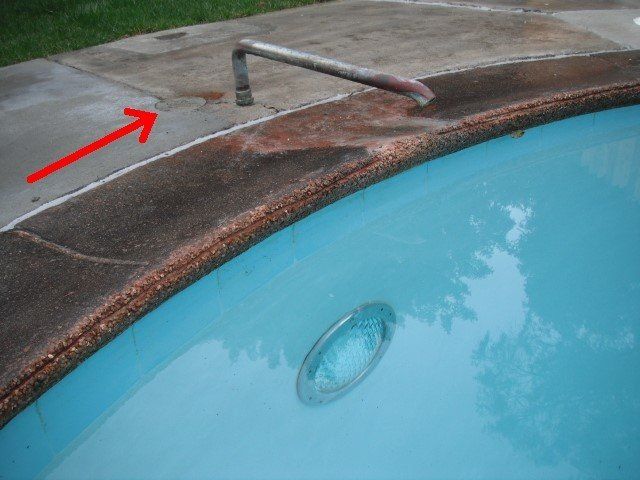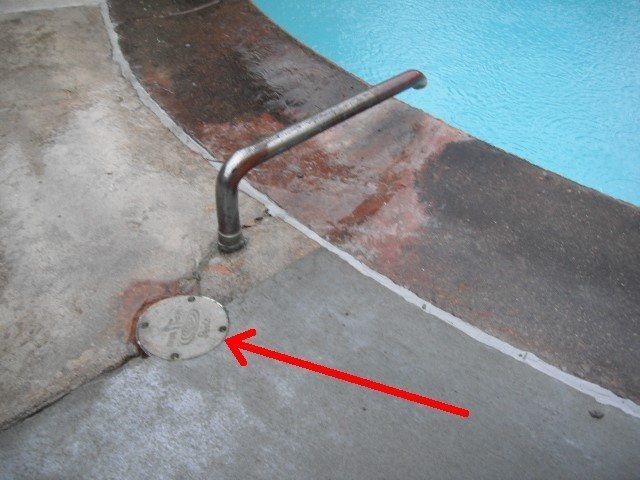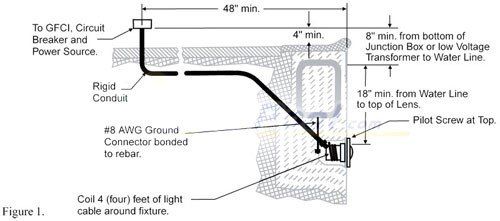In Pool Light Deck Junction Box (J-Box)
Older pools typically have what’s called an “In Deck Junction Box” or J-Box installed just above the fight fixture on the pool deck. In most cases it's directly under a diving board and a few inches from the coping edge . This box is where the cord from the pool light connects to a 110VAC power source. These types of junction boxes are dangerous and NO longer meet current electrical code standards. They have been deemed an electrical hazard due to the possibility of water entering into the junction box and causing electricity to be conducted into the pool water. To make matters worse, most all of these old pools do not have a Ground Fault Circuit Interrupter (GFCI), a device used to protect against any electrical leakage or shock into the pool water.
If your pool has one of these types of junction boxes turn off the power breaker for the light and call a licensed pool technician to have the junction box relocated away from the pool and above the water level to meet current codes, Another option is to replace the light with a low voltage fixture with a low-voltage transformer.
INSTALLATION REQUIREMENTS FOR UNDERWATER POOL LIGHTS & JUNCTION BOXES
Underwater Light GFCI Protection
- Install GFCI protection for underwater lights operating at more than low voltage.
- Do not install underwater lights on circuits operating at more than (>) 150 volts.
Underwater Light Depth
- Install underwater lights so that the top of the light’s lens is at least (≥) 18 inches below the normal water level. This restriction does not apply to lights listed for use at least (≥) 4 inches below normal water level.
- Guard underwater lights with lenses facing other than vertical against human contact. Such a guard may include a substantial plastic cage covering the light’s lens.
Wet-Niche Light Servicing
- Install wet-niche lights so that they can be removed from the niche and placed on the pool deck to change lamps and for other maintenance and inspection. This means installing a cable that is long enough to reach the pool deck.
Underwater Light Junction Boxes
- Use junction boxes listed and labeled for the intended use if using one to connect wires from underwater lights to wires from a panelboard. Size the box to comply with the box contents limitation in Section 3905.
- Connect all metal conduit and grounding terminals to the junction box so that all metal is bonded together.
- Locate junction boxes at least (≥) 4 inches above ground or pool deck level or at least (≥) 8 inches above maximum water level, whichever provides the higher elevation, and at least (≥) 4 feet from the pool or spa inside wall. Do not locate junction boxes in walkways unless they are protected by a fixed structure such as a diving board or a fixed-in-place box.
- You may use deck mounted junction boxes for lights operating at low voltage if an approved potting compound fills the box to prevent moisture entry and if the box is located at least (≥) 4 feet from the pool or spa inside wall.
Underwater Light Device Boxes
- Use device boxes listed and labeled for the intended use if using one to connect wires from underwater lights to a transformer, GFCI, or other device such as a switch. Use a device box that has an air-tight seal between the conduit and the device box. Size the box to comply with the IRC box contents limitation.
- Connect all metal conduit and grounding terminals to the device box so that all metal is bonded together.
- Locate device boxes at least (≥) 4 inches above ground or pool deck level or at least (≥) 8 inches above maximum water level, whichever is higher, and at least (≥) 4 feet from the pool or spa inside wall. Do not locate device boxes in walkways unless they are protected by a fixed structure such as a diving board or a fixed-in-place box.
- Use transformers and power supplies that are listed for swimming pool use to provide power to underwater lights.




